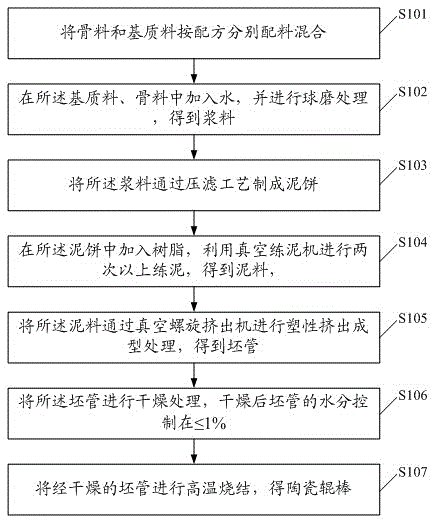Low cost antibending ceramic roller rod and preparing method thereof
A low-cost technology for ceramic rollers, which can be used in the production of ceramic materials, clay products, and other household appliances. It can solve problems such as bending and deformation, and achieve the effects of improving density, reducing emissions, and optimizing formulas and processes.
- Summary
- Abstract
- Description
- Claims
- Application Information
AI Technical Summary
Problems solved by technology
Method used
Image
Examples
preparation example Construction
[0091] Accordingly, such as figure 1 As shown, the present invention also provides a method for preparing a low-cost anti-bending ceramic roller, including:
[0092] S101. Mix the aggregate and matrix material separately according to the formula.
[0093] The raw materials of the ceramic roller include aggregate, matrix material and resin, wherein the main raw material formula of the aggregate in parts by weight is: 30-60 parts of ceramic roller waste;
[0094] The main raw material formula of the base material in parts by weight is:
[0095] 15-40 parts of cordierite
[0096] Alumina 2~15 parts
[0097] Yttrium oxide 0.1~8 parts
[0098] 15~35 parts of clay;
[0099] The above-mentioned cordierite, ceramic roller waste, aluminum oxide, yttrium oxide, and clay total 100 parts by weight, based on this, plus:
[0100] Water-soluble resin, its weight part is 0.1~2 parts.
[0101] Preferably, the weight ratio of the aggregate to the matrix material is 35-50:50-65.
[0102] As a better embodiment ...
Embodiment 1
[0139] (1) Formula:
[0140] 30 pieces of ceramic roller waste
[0141] 30 parts of cordierite
[0142] 10 parts of alumina
[0143] Yttrium oxide 5 parts
[0144] 25 parts of clay;
[0145] 1 part of water-soluble resin.
[0146] Among them, the ceramic roller waste includes: 10 parts of ceramic roller waste with a particle size of 55 mesh, 15 parts of ceramic roller waste with a particle size of 75 mesh, and 5 parts of ceramic roller waste with a particle size of 95 mesh.
[0147] (2) Preparation method:
[0148] (1) Mix 30 parts of ceramic roller waste to obtain aggregate; mix 30 parts of cordierite, 10 parts of alumina, 5 parts of yttrium oxide, and 25 parts of clay to obtain matrix material;
[0149] (2) Ball mill the matrix material and 28 parts of water in a ball mill for 1.5 hours; put the aggregate into the ball milled matrix material, and perform a second ball milling for 0.5 hours to obtain a slurry; Screening and iron removal treatment;
[0150] (3) The slurry is made into a mud ...
Embodiment 2
[0156] (1) Formula:
[0157] 35 pieces of ceramic roller waste
[0158] 25 parts of cordierite
[0159] 8 parts of alumina
[0160] 2 parts of yttrium oxide
[0161] 30 parts of clay;
[0162] 0.2 parts of water-soluble resin.
[0163] Among them, the ceramic roller waste includes: 12 parts of ceramic roller waste with a particle size of 60 mesh, 18 parts of ceramic roller waste with a particle size of 80 mesh, and 5 parts of ceramic roller waste with a particle size of 100 mesh.
[0164] (2) Preparation method:
[0165] (1) Mix 35 parts of ceramic roller waste to obtain aggregate; mix 25 parts of cordierite, 8 parts of alumina, 2 parts of yttrium oxide, and 30 parts of clay to obtain matrix material;
[0166] (2) Ball mill the matrix material and 30 parts of water in a ball mill for 2 hours; put the aggregate into the ball milled matrix material, and perform the second ball milling for 0.6 hours to obtain a slurry; Screening and iron removal treatment;
[0167] (3) The slurry is made into a...
PUM
| Property | Measurement | Unit |
|---|---|---|
| particle size | aaaaa | aaaaa |
| particle size | aaaaa | aaaaa |
| particle size | aaaaa | aaaaa |
Abstract
Description
Claims
Application Information
 Login to View More
Login to View More - R&D
- Intellectual Property
- Life Sciences
- Materials
- Tech Scout
- Unparalleled Data Quality
- Higher Quality Content
- 60% Fewer Hallucinations
Browse by: Latest US Patents, China's latest patents, Technical Efficacy Thesaurus, Application Domain, Technology Topic, Popular Technical Reports.
© 2025 PatSnap. All rights reserved.Legal|Privacy policy|Modern Slavery Act Transparency Statement|Sitemap|About US| Contact US: help@patsnap.com

